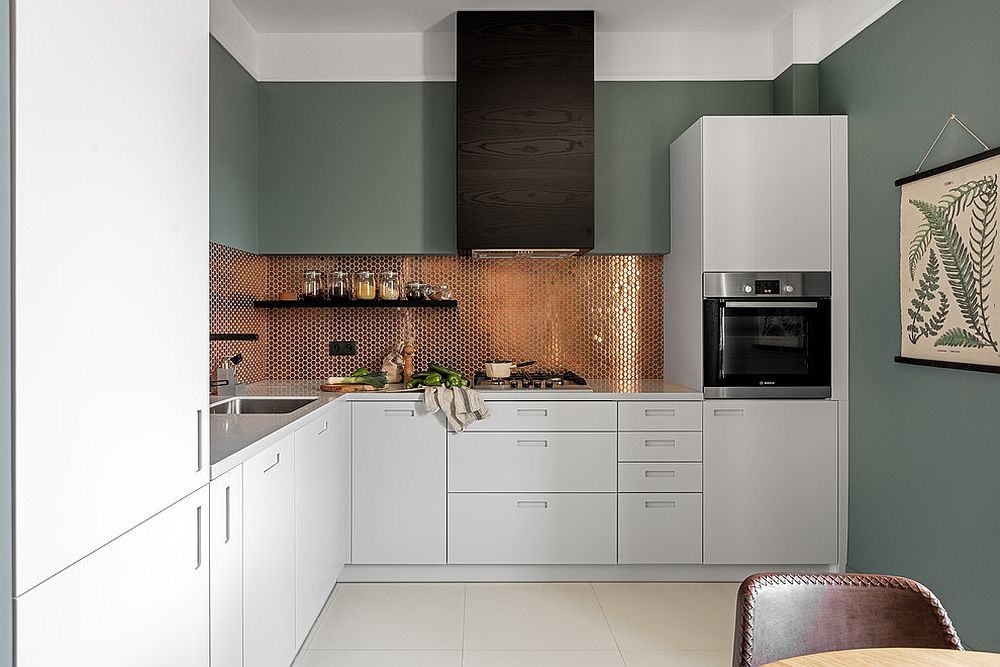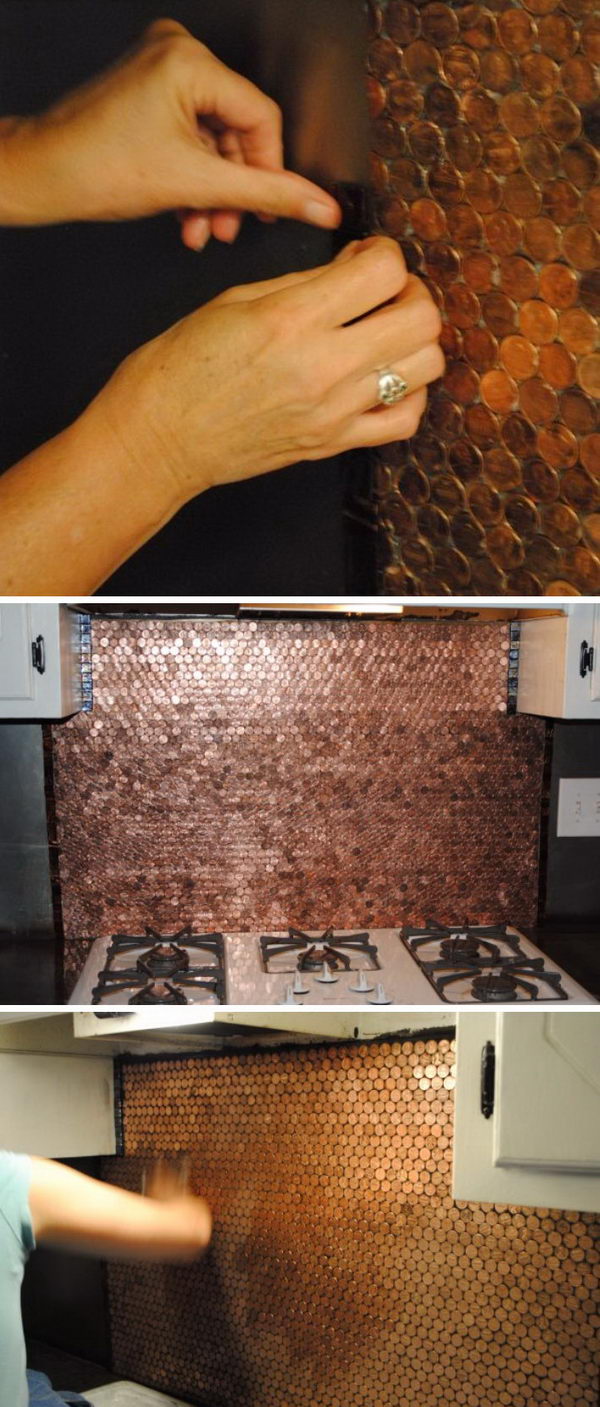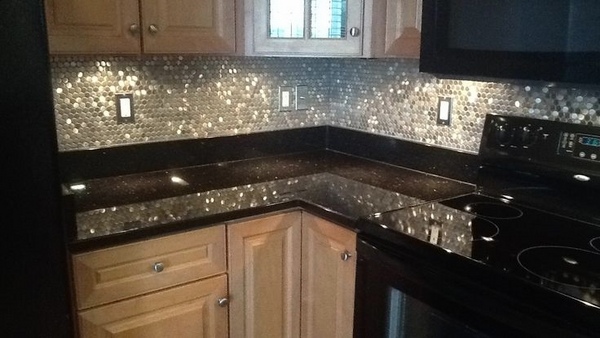A copper penny kitchen backsplash is a bold and unique design choice that brings a touch of luxury, warmth, and character to any kitchen. Copper as a material has been used for centuries for its durability, beauty, and malleability, making it an ideal choice for home design. The copper penny backsplash concept involves using penny-sized copper tiles or actual copper pennies, meticulously arranged to create a stunning, textured effect. The reflective qualities of copper lend an elegant and warm glow to the kitchen, catching light in beautiful ways and enhancing the overall ambiance. Whether you’re aiming for a rustic, industrial, or modern aesthetic, a copper penny backsplash can be customized to suit different design themes.
One of the standout features of copper penny kitchen backsplashes is their timeless appeal. Copper ages beautifully, developing a natural patina over time that adds depth and uniqueness to the material. This change is part of copper’s charm, offering a living surface that evolves with your kitchen’s environment. If you prefer the look of bright, shiny copper, regular polishing can maintain its luster. Alternatively, you can embrace the aged patina for a more antique, vintage look that fits seamlessly into traditional or farmhouse-style kitchens. This flexibility makes copper penny backsplashes a versatile option for various interior styles.

The installation process for a copper penny backsplash can be as intricate or straightforward as you want. Many homeowners choose to use sheets of copper penny tiles, which are pre-arranged and make for easier installation. For those seeking a more personalized touch, actual copper pennies can be arranged by hand to create custom patterns or designs, though this option requires more time and precision. Regardless of the method, a copper penny backsplash can serve as the focal point of your kitchen, drawing attention and adding a striking visual element. The intricate detailing of each penny, combined with the copper’s reflective quality, creates a rich tapestry of texture and color.
In terms of durability, copper penny kitchen backsplashes are a strong choice. Copper is naturally resistant to corrosion and damage, meaning it can withstand the daily rigors of a busy kitchen, including exposure to heat, moisture, and food splatters. When properly sealed, a copper penny backsplash is also easy to clean and maintain. The sealant creates a protective barrier against stains, grease, and watermarks, which are common in kitchen environments. This durability makes it not only beautiful but also a practical choice for homeowners who want a long-lasting backsplash that stands up to daily wear and tear.

Copper penny backsplashes are also highly customizable. Homeowners can choose from different finishes, including polished, brushed, or patinated copper, to achieve the desired look. Additionally, the arrangement of the pennies can be varied to create different patterns. A traditional grid arrangement can offer a clean, orderly look, while a more randomized layout can give the backsplash a more organic, artisanal feel. For added visual interest, some homeowners mix copper pennies with other materials, such as glass or ceramic tiles, to create a more eclectic design. The ability to customize the layout, finish, and materials makes copper penny backsplashes a unique and highly personal design choice.
Beyond aesthetics, a copper penny backsplash can also enhance the functionality of your kitchen. Copper has natural antimicrobial properties, which means it inhibits the growth of bacteria and other harmful microorganisms. This makes copper a hygienic option for kitchens, where cleanliness is a priority. The copper surface actively kills bacteria, making it a practical choice for homeowners concerned about kitchen hygiene. This functional benefit, combined with the material’s natural beauty, makes copper penny backsplashes a standout option for both form and function in the kitchen.

While copper penny backsplashes are a visually stunning addition, they do require some maintenance to keep them looking their best. Over time, copper will naturally oxidize and change color, developing a greenish patina known as verdigris. Some homeowners love this aged look, as it adds character and history to the backsplash, while others prefer the shiny, new copper appearance. To maintain the bright copper finish, regular cleaning with a non-abrasive cleaner is necessary, along with occasional polishing. For those who prefer the aged look, allowing the copper to naturally evolve without interference can create a beautiful, weathered appearance over time.
One of the main reasons copper penny backsplashes have become popular is their ability to add warmth to the kitchen. Copper’s reddish-brown hues instantly create a cozy, inviting atmosphere, which can be especially appealing in open kitchen layouts where warmth and comfort are essential. Copper reflects light in a soft, warm way, making the kitchen feel brighter without the harshness that sometimes comes with stainless steel or glass backsplashes. This makes copper penny backsplashes a great option for homeowners looking to strike a balance between modern design and a homey feel.
Copper penny backsplashes also offer a unique conversation piece. Whether you choose to use actual pennies or copper penny tiles, the detailed texture and historical significance of each penny invite intrigue. Guests will naturally be drawn to the backsplash, admiring the craftsmanship and originality of the design. For some homeowners, using actual copper pennies carries sentimental value, as they may incorporate coins from specific years or locations that hold personal significance. This adds a layer of storytelling to the kitchen, making the backsplash not just a design element but also a meaningful personal statement.

The cost of a copper penny backsplash can vary depending on the method of installation and materials used. If you choose copper penny tiles, the cost may be higher than more common backsplash materials like ceramic or glass tiles. However, the unique visual impact and longevity of copper penny backsplashes often justify the investment for homeowners looking to make a bold design statement. For those on a tighter budget, DIY options using actual copper pennies can be more affordable, though they require significantly more time and effort. The value of a copper penny backsplash lies in its aesthetic impact and durability, making it a worthwhile investment for many homeowners.
Another benefit of copper penny backsplashes is their ability to complement a wide range of kitchen materials and finishes. Copper pairs beautifully with wood, marble, granite, and stainless steel, allowing for seamless integration into various kitchen designs. In industrial-style kitchens, copper adds a rugged, vintage feel that enhances the overall aesthetic, while in more traditional or farmhouse kitchens, copper’s warm tones create a rustic, inviting ambiance. Whether your kitchen features modern sleek surfaces or more rustic, natural materials, a copper penny backsplash can tie the space together and add a cohesive, polished look.
Copper penny backsplashes also offer a high degree of visual interest due to the varied colors and textures of the pennies. While copper is known for its warm, reddish-brown tones, each penny can have slightly different hues depending on its age and condition. Some pennies may appear darker or more worn, while others may be brighter and more polished. This color variation creates depth and dimension, adding a dynamic, ever-changing quality to the backsplash. The result is a textured surface that catches the light in different ways, creating a sense of movement and liveliness in the kitchen.

When it comes to cleaning and maintaining a copper penny backsplash, it’s important to use gentle, non-abrasive cleaners to avoid damaging the surface. Harsh chemicals can strip the copper of its protective coating or cause discoloration, so it’s best to stick to mild soap and water for everyday cleaning. Additionally, wiping the backsplash regularly with a soft cloth will help prevent the buildup of grease and grime, keeping the surface looking clean and polished. For homeowners who prefer a shiny copper finish, periodic polishing with a copper-specific polish will help maintain the bright, reflective surface.
For those who want to enhance the longevity of their copper penny backsplash, applying a high-quality sealant is essential. The sealant not only protects the copper from moisture and oxidation but also helps preserve the finish, whether you prefer a shiny or aged patina. Without proper sealing, copper can tarnish or develop unwanted stains, particularly in a kitchen environment where it may be exposed to water, food splatters, and grease. Regularly applying a sealant will help keep the copper looking its best, ensuring that your backsplash remains a focal point in the kitchen for years to come.
A copper penny kitchen backsplash is an excellent way to add a touch of luxury and warmth to your kitchen while also providing a durable and functional surface. Its combination of aesthetic appeal, durability, and customizability makes it a versatile design choice that can complement a wide range of kitchen styles. Whether you prefer a polished, modern look or a more rustic, aged patina, copper penny backsplashes offer a timeless and unique design solution that can elevate the look of your kitchen and add a personalized touch to your home.

Common Mistakes to Avoid
One common mistake when installing a copper penny backsplash is failing to properly seal the surface. Without a sealant, the copper can tarnish or develop stains from exposure to water, grease, and food.
Another mistake is using harsh or abrasive cleaners, which can damage the copper and strip away its protective coating. When installing the backsplash, it’s also important to ensure that the pennies or tiles are arranged evenly and securely to avoid gaps or uneven surfaces.
Additionally, some homeowners mistakenly assume that copper penny backsplashes require no maintenance; however, regular cleaning and sealing are essential to maintaining their appearance. Finally, using low-quality or improper adhesives during installation can lead to tiles or pennies coming loose over time.

How do I clean and maintain my copper penny backsplash?
Cleaning and maintaining a copper penny backsplash is relatively simple but requires care. For everyday cleaning, use a mild soap and water solution with a soft cloth to wipe down the surface. Avoid using harsh chemicals or abrasive scrubbers, as they can damage the copper’s finish. If you prefer a shiny copper appearance, regular polishing with a copper-specific polish will help maintain the luster. Additionally, it’s important to apply a high-quality sealant to protect the copper from moisture, stains, and tarnishing, especially in high-use areas like kitchens.
Will my copper penny backsplash develop a patina over time?
Yes, copper naturally develops a patina as it oxidizes, which gives it a unique greenish-blue appearance. This process can be slowed or prevented by regularly polishing the copper and applying a sealant. However, many homeowners appreciate the patina for its vintage, aged look, as it adds character and history to the backsplash. If you prefer to maintain the bright, shiny appearance of new copper, you’ll need to clean and polish the surface regularly to prevent the patina from forming.
Can I use real copper pennies for my backsplash?
Yes, many homeowners choose to use actual copper pennies for their backsplash, either for aesthetic reasons or to create a unique, personalized design. While this can be a more affordable option than copper penny tiles, it requires more time and precision during installation. Each penny must be individually placed and secured, and the entire surface needs to be sealed to protect against moisture and tarnishing. Using real pennies can add a layer of historical or sentimental value, especially if specific years or locations are incorporated into the design.

How durable is a copper penny backsplash in the kitchen?
Copper penny backsplashes are quite durable when properly sealed and maintained. Copper is naturally resistant to corrosion, and its antimicrobial properties make it a hygienic choice for kitchen environments. However, because copper is a softer metal, it can scratch or dent if exposed to sharp objects or heavy impacts. To ensure its durability, it’s essential to use a sealant and avoid rough handling of the surface. With proper care, a copper penny backsplash can last for many years while maintaining its beauty.
Is a copper penny backsplash expensive to install?
The cost of installing a copper penny backsplash can vary depending on the method of installation and materials used. Copper penny tiles tend to be more expensive than other types of backsplash materials like ceramic or glass, but they offer a unique and luxurious look. For a more budget-friendly option, some homeowners opt to use real copper pennies, though this requires significantly more time and effort for installation. Overall, the cost of a copper penny backsplash is often justified by its aesthetic appeal and long-term durability.
Can I install a copper penny backsplash myself, or should I hire a professional?
While it is possible to install a copper penny backsplash yourself, it can be a time-consuming and intricate process, especially if you’re using real pennies. For homeowners with DIY experience, installing copper penny tiles may be more manageable, as the tiles come pre-arranged for easier installation. However, if you want a more customized design or are unsure about the process, hiring a professional is recommended to ensure that the backsplash is installed evenly and securely. A professional installation also ensures that the appropriate sealants and adhesives are used for long-lasting durability.

Related Posts:
- White Kitchen Mosaic Backsplash
- Beige Backsplash For Kitchen
- Temporary Kitchen Backsplash For Renters
- Split Face Tile Kitchen Backsplash
- Kitchen Backsplash Design Tool
- Craftsman Kitchen Tile Backsplash
- Tiling Kitchen Backsplash Corners
- Rooster Kitchen Backsplash
- Replace Kitchen Backsplash Cost
- Tile Kitchen Backsplash Youtube